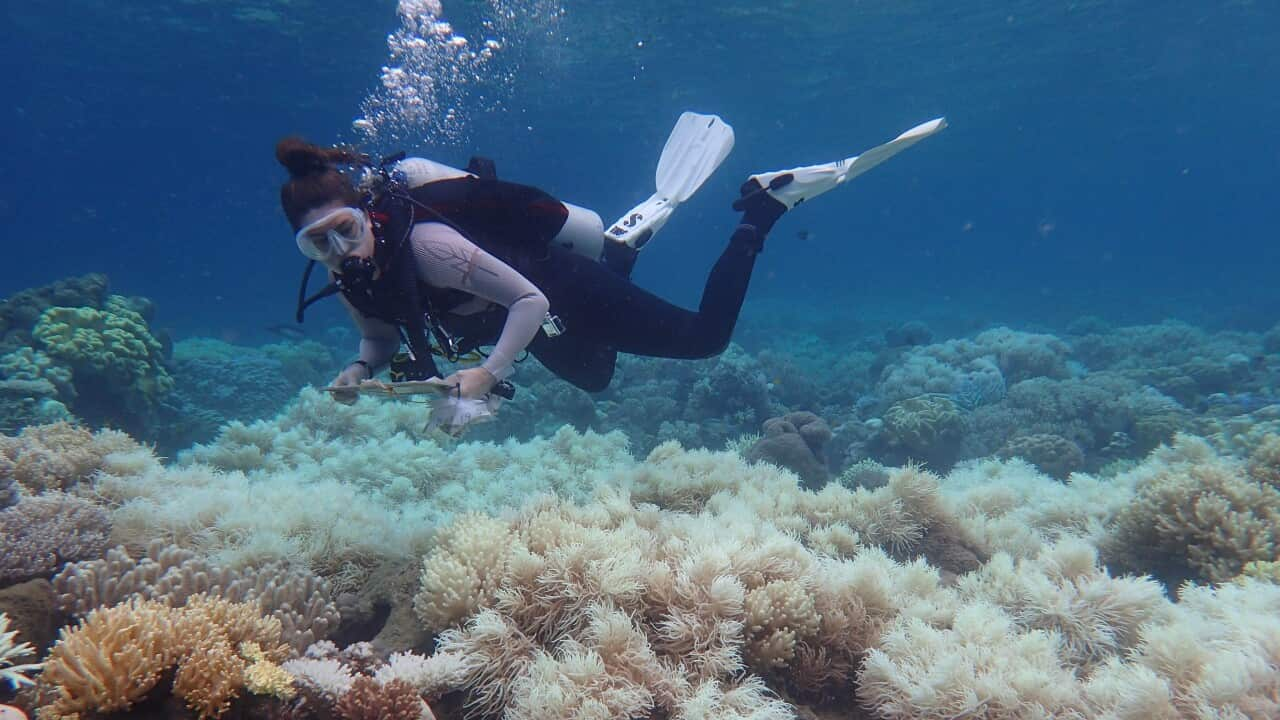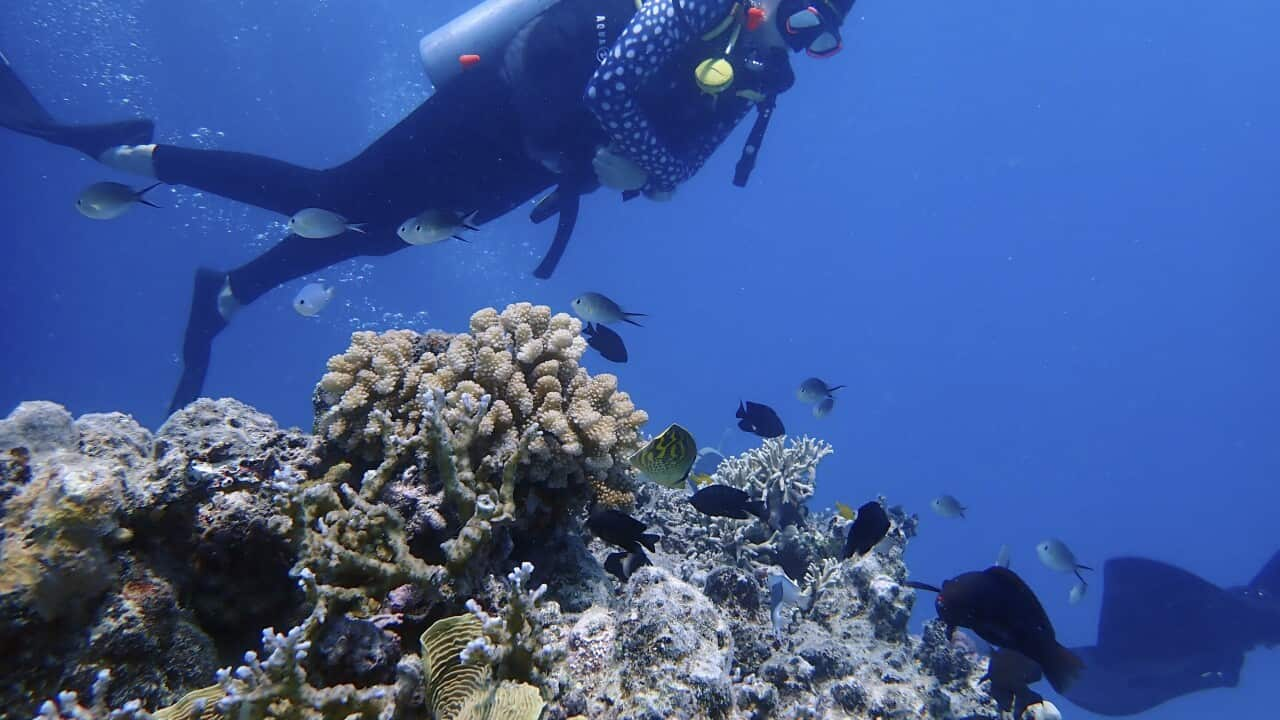The Great Barrier Reef has suffered its first-ever mass coral bleaching during the La Niña weather cycle and cannot handle “escalating" climate change, according to a scientist who helped write an as yet unpublished report.
The annual ‘Reef Summer Snapshot 2021-22’ - prepared by the Great Barrier Reef Marine Park Authority (GBRMPA) with the Australian Institute of Marine Science (AIMS) and the CSIRO - was initially expected in April.
The federal government and the Australian Institute of Marine Science (AIMS) have denied there was political interference in the delayed release of the highly anticipated report ahead of the federal election.
“There is no hiding it, there’s been no political coercion, there’s nothing like that going on,” Dr Paul Hardisty, CEO of AIMS told SBS News.

Heatmap of the 2021/22 mass coral bleaching. Source: Supplied
This year the initial confirmation of severe and widespread mass coral bleaching in March coincided with a UNESCO inspection of the reef, in preparation for a meeting to decide whether to re-list the 350,000 square kilometre World Heritage Site as “in danger”.
Last year UNESCO decided not to put the reef on the list after intensive global lobbying from the Australian government.
The delegation was briefed on the data contained in the unreleased report.
Data ‘everybody’s been waiting to see’
SBS News has obtained a transcript of an AIMS staff briefing this week on the unreleased report by researcher Dr Neal Cantin detailing the fifth mass bleaching in two decades.

A photo taken in October 2016 shows coral bleaching on the Great Barrier Reef, a World Heritage Site. Source: AAP / AP
“This is the data everybody’s been waiting to see,” Dr Cantin told about 200 AIMS staff in a webinar on Wednesday.
Maps and graphs from the report give a detailed overview of the extent of the damage and Dr Cantin’s interpretation of the bleaching data was devastating.
“It’s not a good sign and it’s happening more frequently and it happened for the first time during a La Niña event, so it is a clear sign of climate change escalating at the rate the reef isn’t keeping up with,” he said.
“I would expect the next El Niño - unless we get lots of cyclone activity along with the heat - to present a riskier summer, something as bad or worse than 2016,” Dr Cantin said.

Two images of coral near Lizard Island on the Great Barrier Reef. The image on the left was taken before March 2016, and the one on the right was taken after May 2016, showing coral bleaching and coral death. Source: AAP / AP
Dr Cantin said it remained at that level through mass bleachings in 2017, 2020 and this year.
But he said the surveys conducted from December to March along the length of the reef from the Torres Strait to the Whitsundays found bleaching began earlier than usual - and lasted longer.

Graph of summer sea surface temperature anomaly on the Great Barrier Reef. Source: Supplied
“The far-north heated early,” he said.
“There was intense stress through the month of December … up to eight degree heating weeks,” he said.
“It’s really the final heatwave in March that pushed the central and southern Great Barrier Reef over the edge,” he said, but added that “less mortality” is expected this year.
The briefing was told that this year was not as hot as 2016 but bleaching was more widespread, including “extensive and severe” bleaching from Cairns to the Whitsundays.
“Magnetic Island, Palm Island group, the inshore islands around Cairns, Fitzroy and Green islands were particularly bad,” he said.
Dr Hardisty from AIMS confirmed the details of the findings presented by Dr Cantin and added that “the long term prognosis for the reef is very poor".
“If a really intense El Niño develops in the future, it’s going to be pretty dire.”

Water temperatures as monitored by the Davies Reef weather station. Source: Supplied
There has been speculation in the media this week that the timing of the report has been politicised.
“Unfortunately we did not get (the report) out in time for the election and have been guided by the prime minister’s office (PMO), under caretaker mode, that we need to withhold the data until after the election for public release,” Dr Cantin said in the webinar.
Dr Hardisty said Dr Cantin mixed up the PMO with the Department of Prime Minister and Cabinet (PMC) , which advises on caretaker rules.
“I corrected that error quite quickly (at the meeting),” he said.
“There are three agencies involved, there are two (federal) departments, we don’t make up the rules, we are not experts on the conventions. There’s a route you have to follow.”

Accumulated heat stress map across the Great Barrier Reef from 1996-2022.
In a statement the Great Barrier Reef Marine Authority (GBRMPA) said: “While there is no due date or legislative requirement to publish the Snapshot at a particular time … (we) are working to publish the document as soon as practicable.”
In response to questions from SBS News, the prime minister’s office issued a statement from environment minister Susan Ley.
“Three respective agencies are working to release the Reef Snapshot. Timing is at the discretion of those agencies,” it said.
“The government has not been offered a briefing on the Snapshot and has not issued any instructions in relation to it.”


